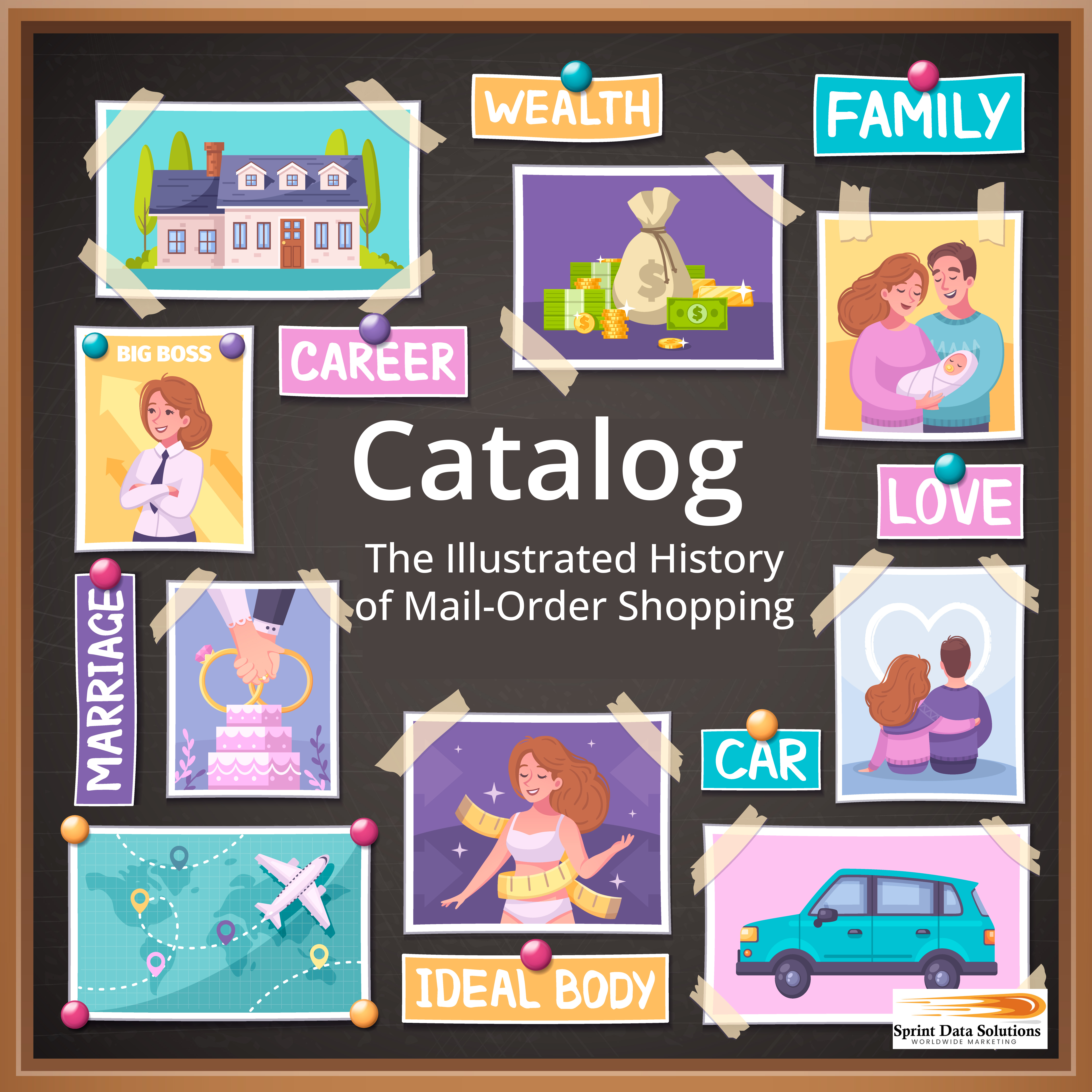Catalog & Magazine Mailing List
The 21st century has brought remarkable shifts in the way people engage with traditional activities, and shopping is no exception. In previous decades, shopping was an experience rooted in physical spaces, such as local markets or bustling shopping malls, where people interacted face-to-face with store personnel and products. However, the digital revolution has reshaped how we shop, allowing individuals to purchase products from the comfort of their homes with just a few clicks, all thanks to the growth of online marketplaces and e-commerce websites. This transformation has made online shopping an integral part of modern life, giving consumers unparalleled convenience and variety.
Despite the rise of online shopping, one classic marketing tool has maintained its relevance: the catalog. A relic of a time when print media ruled the advertising world, the catalog still serves an important role in the marketing ecosystem. While the internet has digitized many aspects of our daily lives, catalogs continue to provide a tangible, curated shopping experience. Today, businesses often blend traditional catalog marketing with digital strategies, creating a hybrid approach that taps into both physical and online realms. For example, modern catalogs often feature QR codes or personalized URLs that lead customers to exclusive offers on websites, merging the convenience of print with the ease of digital navigation.
The catalog’s historical significance is also seen in its impact on modern retail design. The way products are organized and presented on retail websites is often rooted in the format established by catalogs, where items were grouped by category, with clear pricing and descriptions. This layout continues to inform the user experience on e-commerce platforms, making it easier for customers to navigate product offerings and find what they need.
Catalogs also thrive alongside other traditional media like magazines, continuing to occupy a vital marketing niche. For businesses aiming to connect with consumers who still value printed material, catalogs and magazines offer an effective avenue. Despite the shift toward digital consumption, many shoppers still prefer the tactile experience of browsing through a catalog or flipping through a magazine while enjoying the simplicity of a focused, curated list of products.
At Sprint Data Solutions Worldwide Marketing, we understand the significance of catalog and magazine marketing in today’s multifaceted media landscape. Our services cater to businesses seeking to reach these traditional yet enduring markets, leveraging advanced data analytics to identify and target the right audiences. Whether you’re looking to capitalize on the catalog-consuming demographic, magazines with loyal readerships, or a blend of both, we provide customized data solutions that ensure your marketing efforts are both effective and far-reaching.
The Sprint Data Solutions Worldwide Marketing Story
Sprint Data Solutions Worldwide Marketing is a proudly American-owned and operated company, founded by a disabled veteran with a vision to contribute to the nation’s economy by focusing on business growth rather than defense. After fulfilling the responsibilities of serving the country, the decision was made to pivot from defense to economic growth, leading to the creation of Sprint Data Solutions Worldwide Marketing. The company was established with the goal of empowering American businesses to expand their most valuable asset: their customer base. It began its journey in Las Vegas, Nevada, where it laid the foundation for a thriving enterprise.
Over the years, Sprint Data Solutions Worldwide Marketing has experienced consistent growth and success, driven by a dedicated team with over 50 years of combined expertise in the marketing and sales sectors. The company’s early focus was on direct mail marketing, a sector that was still heavily influenced by traditional, analog platforms such as print and television advertising. Direct mail marketing, despite the rise of digital channels, continues to be a core offering of the company to this day, as it remains an incredibly effective way to engage customers, provide personalized messaging, and drive results.
As the business flourished, Sprint Data Solutions Worldwide Marketing expanded its services beyond Las Vegas, initially covering the state of Nevada. The company soon broadened its reach, providing services to the entire United States, including Hawaii and Alaska. It continued its growth trajectory by expanding into North America, establishing a presence in Mexico and Canada. Sprint Data Solutions Worldwide Marketing then took its operations to the global stage, extending its services to European Union markets such as France.
Despite its success in the direct mail space, the company recognized the need to adapt to the evolving digital landscape. As the internet gained prominence, Sprint Data Solutions Worldwide Marketing strategically integrated digital marketing services into its offerings. This allowed the company to meet the growing demands of the online business world, providing a diverse range of digital marketing solutions alongside traditional direct mail. Through the use of cutting-edge technologies, Sprint Data Solutions Worldwide Marketing has been able to serve businesses across industries, helping them thrive in an increasingly digital and interconnected world.
With a combination of tried-and-true methods and innovative digital strategies, Sprint Data Solutions Worldwide Marketing has continued to build long-lasting relationships with clients, ensuring their success through targeted, data-driven marketing campaigns. Today, the company is recognized for its unparalleled expertise, commitment to customer service, and ability to adapt to the ever-changing marketing landscape. From local beginnings to international operations, Sprint Data Solutions Worldwide Marketing is a testament to the power of growth, innovation, and dedication to excellence.

The Catalog & Magazine Advantage
In today’s fast-paced digital world, where online shopping has become the norm, there remains a strong, nostalgic appeal to physical catalogs and magazines. While these print mediums may seem outdated at first glance, they continue to hold significant value due to their tactile nature and the personal touch they offer to consumers. Despite the rise of e-commerce platforms, catalogs and magazines still serve as a powerful marketing tool, as they provide an experience that digital channels cannot fully replicate.
Before the internet era, catalogs were the primary method for businesses to showcase their products to a wide audience, often requiring customers to visit a physical store, mail in an order form, or make a phone call to place their order. These print catalogs offered customers a curated, detailed selection of products, often accompanied by beautiful visuals and descriptions, enticing them to make purchases from the comfort of their homes. Even as online shopping became more prevalent, catalogs did not become obsolete. Instead, they evolved to work in tandem with digital platforms, offering businesses a unique opportunity to engage with customers in a way that online stores often cannot.
Magazines, much like catalogs, have maintained their charm due to their superior production value and high-quality content. With expert editorial teams and professional design, magazines have the power to captivate their audience in ways that websites sometimes cannot. A well-curated magazine offers readers a visual and emotional experience that stands out from the cluttered and often impersonal feel of digital media. In addition, unlike websites that require a constant internet connection, magazines can be consumed offline, allowing readers to enjoy them in various settings without relying on a network connection.
The true value of catalogs and magazines lies in their ability to bypass the digital noise that consumers face daily. Email inboxes are often filled with countless promotional messages, many of which go unnoticed. In contrast, a thoughtfully designed catalog or magazine can make a lasting impression, offering consumers a tangible and memorable experience. When paired with modern digital ordering systems, catalogs and magazines remain an effective marketing tool for businesses, as they offer an easy and efficient transition from the physical world to the digital one. Whether through a call or online ordering via a smartphone or computer, businesses can bridge the gap between the offline experience and the convenience of digital transactions.
For industries such as fashion, home décor, outdoor gear, and even specialty services, catalogs and magazines continue to be a valuable means of marketing. When executed well, they provide businesses with the opportunity to connect with their target audience in a more personal, immersive way than online advertising or digital storefronts alone. By leveraging the unique strengths of print media and combining them with the ease of digital transactions, businesses can create an experience that resonates with consumers long after they have turned the page or browsed the catalog.
Home Cooking Magazines
The pandemic significantly reshaped consumer behaviors, particularly in regard to dining habits. As lockdowns and health concerns kept people at home, many individuals rediscovered the benefits of home cooking. Today, even as the pandemic subsides, the shift toward preparing meals at home continues to hold strong, as people increasingly view it as a more budget-friendly option compared to dining out regularly. This change in behavior is driven by both financial considerations and a desire for healthier, more customized meal options.
Cooking magazines, in particular, have seen a resurgence during this period, serving as a trusted resource for meal ideas, recipes, and culinary inspiration. Unlike digital devices, which can be prone to distractions, spills, and the risk of screen damage, magazines offer a more reliable and accessible format in the kitchen. Their tangible nature allows for easier navigation and referencing while cooking, providing a more seamless experience for those looking to try new recipes. Additionally, cooking magazines often feature step-by-step instructions, tips, and nutritional information, all in a user-friendly format, making them a valuable companion for both novice home cooks and seasoned chefs.
Fine Wines
Wine is more than just a drink; it’s a rich, multifaceted world that has captivated enthusiasts for centuries. For many, wine is a lifelong passion, a hobby that can be pursued through exploration, tasting, and collecting. Wine is often associated with sophistication, and its appeal transcends various levels of consumption. From everyday table wines to luxurious, limited-edition bottles, wine is enjoyed by people from all walks of life. High-quality wines from renowned vineyards, often celebrated for their complexity and aging potential, attract connoisseurs who value both the taste and history behind each bottle. On the other hand, wines designed for more casual consumption can offer a sense of connection to the culture without the investment required for fine wines.
Wine magazines and catalogs play an essential role in maintaining this culture, as they offer knowledge and context that enrich the experience of wine enthusiasts. It’s not just about showcasing the latest bottle – these publications immerse readers in the culture, history, and evolving trends within the wine world. From educational articles about the art of winemaking and wine tasting techniques to highlighting regional varietals and emerging trends, the content often combines informative storytelling with a visual celebration of fine wines.
In addition to standard varietals, specialty wines like ice wine or sparkling varieties are celebrated for their unique qualities, making them a focal point for occasions like weddings or holidays. Wine is frequently viewed as a marker of milestones and special events, a tradition passed down through generations. As such, marketers need to understand the nuances of this demographic, curating content that blends rich cultural knowledge with trends that reflect current consumer interests. Wine marketing can span a wide range of economic levels and cultural references, from accessible bottles to niche, high-end collectors’ editions, ensuring there’s something for every type of wine lover. The ability to convey both the art and science of wine is key to connecting with a wine-loving audience that is both knowledgeable and passionate about their taste.

Cigars
Cigars, much like wine, are often seen as a symbol of luxury and indulgence. As a product with a long history, cigars are enjoyed by connoisseurs who appreciate the rich tradition behind them. Unlike cigarettes, cigars are typically consumed less frequently, often reserved for special occasions or moments of relaxation. This makes them a premium item, and as such, their consumption is often associated with a more sophisticated lifestyle.
Cigars, like wine, are an acquired taste. Enthusiasts tend to appreciate the subtle differences in flavor, strength, and aroma that come with each cigar, making experimentation a key part of the enjoyment. As with wine tasting, the variety within the world of cigars is vast, with different regions and brands offering unique profiles. For cigar lovers, the opportunity to explore different flavors, ages, and blends is an enticing aspect of the culture.
As consumables, cigars share a similar replenishment cycle with wine—once a preferred supply runs out, there’s a need for restocking, which opens up opportunities for exploration. Just as wine collectors continuously expand their cellars, cigar aficionados often seek to build their collection or explore new offerings.
Effective marketing for cigars, much like wine, requires a refined approach. Proper presentation, storytelling, and educational content can create a deeper connection with the target audience. Informative materials such as tasting notes, comparisons, and recommendations can help consumers navigate the vast range of options and enhance their experience. By focusing on the nuances of different cigars—whether it’s the craftsmanship, the history, or the particular characteristics of the tobacco—marketers can draw in both seasoned enthusiasts and newcomers to the world of cigars, resulting in more engagement and sales.
Understanding the mindset of cigar lovers is crucial for a successful campaign. Marketing efforts should emphasize the premium nature of cigars, connecting them to a lifestyle of relaxation, refinement, and celebration. When targeted effectively, cigars can appeal to a market that values quality, tradition, and a sense of luxury—allowing brands to stand out in a competitive market.
Household Goods
Homes are complex environments that require a wide variety of products to function efficiently and maintain comfort throughout the year. From essential cleaning supplies like dishwashing soap and laundry detergent to more specialized items such as air filters, batteries for smoke detectors, and winter sidewalk salt, the list of products necessary to keep a home running smoothly is extensive. Each room of the house, whether it’s the kitchen, bathroom, or living room, has specific needs that demand different types of products—ranging from cookware and cleaning agents to personal care items and home improvement tools. Catalogs serve as a valuable resource, offering an organized and detailed selection of products for every household need, while magazines often provide insights into the best products on the market, practical tips on maintaining home systems, and expert advice on optimizing the use of these products. With the right guidance, homeowners can ensure that their homes remain functional, comfortable, and well-maintained all year round.
Children’s Products
The market for children’s products is vast and continues to grow, encompassing a wide range of categories such as educational tools, developmental resources, health and nutrition products, and entertainment. As parents seek to provide the best for their children, the demand for high-quality, innovative products in these areas remains high. Catalogs specifically designed for children’s products reflect this diversity, showcasing everything from toys and books to clothing and tech gadgets. Among the most impactful ways to reach parents and caregivers, children’s magazines hold significant potential. These magazines cater to an engaged audience of parents, grandparents, and other caregivers who are keen to discover new and useful products. Parents are always on the lookout for products that can enhance their child’s development, improve their well-being, or make daily life easier. With an ever-growing interest in child-rearing solutions, these publications become an invaluable resource for not only showcasing products but also providing trusted recommendations, expert insights, and parenting tips. Through these magazines, brands can connect directly with a highly receptive audience eager to learn about the latest trends and innovations in the children’s products market.
CBD Oil & CBD Creams
As cannabis legalization continues to spread across the United States, CBD oil has swiftly gained traction as an effective and non-intoxicating treatment for a variety of ailments, including stress, chronic pain, and digestive issues. Unlike THC, the psychoactive component of cannabis, CBD oil offers therapeutic benefits without inducing the high typically associated with marijuana. This makes CBD a versatile product, appealing to a broad spectrum of consumers, from those seeking relief from physical discomfort to individuals looking to address mental health concerns like anxiety.
Seniors, in particular, have become a key demographic for CBD oil products, with many turning to CBD as a natural solution for managing conditions like arthritis, back pain, and general age-related discomfort. The growing acceptance of CBD among older adults stems from its reputation as a safer alternative to traditional pain medications, such as opioids, which can carry significant risks of addiction and side effects. This shift presents unique marketing opportunities, as seniors are actively seeking products that promote health and wellness without the adverse effects associated with more potent pharmaceutical treatments.
On the other hand, athletes are also tapping into the benefits of CBD, though their needs and usage patterns differ significantly from those of seniors. For athletes, CBD oil, particularly in the form of topical creams or balms, is commonly used for post-workout recovery and muscle soreness. Athletes may look for products that offer quick relief for inflammation, bruising, or joint pain, with an emphasis on speed and efficiency in their recovery routines.
To effectively target these distinct customer groups, marketing strategies for CBD products must be tailored to their unique needs. For seniors, the focus may center on the health and safety aspects, emphasizing natural relief and ease of use. For athletes, the messaging can highlight recovery and performance enhancement, appealing to their desire for fast, effective solutions to muscle and joint issues.
Additionally, marketing materials such as magazines and catalogs are ideal for reaching these diverse audiences, providing in-depth product information and testimonials that resonate with each group’s specific concerns. By catering to the distinct needs of seniors and athletes, businesses can successfully position CBD oil as a multifaceted remedy with widespread appeal.
Sports Magazines & Products
Sports magazines have been a staple in the media landscape for decades, serving as an essential source of information for fans, athletes, and industry professionals. These magazines provide in-depth coverage of sports events, athlete profiles, training techniques, and behind-the-scenes insights that keep fans engaged and informed. Whether covering popular mainstream sports like basketball, soccer, or football, or delving into niche sports like bobsledding, curling, or archery, the demand for comprehensive, detailed content remains strong. As sports evolve and attract diverse audiences, the need for specialized coverage continues to grow.
In tandem with the demand for sports information, there is an ever-present need for magazines and catalogs that highlight sporting products. From athletic wear to equipment, supplements, and accessories, magazines focused on sporting goods offer essential guidance for consumers seeking the right products to enhance their performance. These magazines go beyond just showcasing products; they often provide expert reviews, performance comparisons, and detailed specifications that allow enthusiasts to make informed purchasing decisions. The key to success in this sector lies in tailoring product catalogs and magazines to specific sports, ensuring that the products being highlighted resonate with the target audience’s interests and needs. Whether it’s promoting the latest advancements in basketball sneakers or the most efficient training tools for winter sports like skiing or bobsledding, aligning the right products with the right enthusiasts is crucial for reaching a receptive market. As a result, sports product magazines continue to be a vital resource, driving both consumer education and sales within the ever-expanding sports industry.
Seeds & Plants
Gardening has long been a cherished activity in many American households, and with growing concerns over sustainability and the desire to reduce environmental footprints, its popularity is experiencing a resurgence. As people look for ways to reconnect with nature and cultivate their own food, gardening has become a rewarding and cost-effective hobby. Alongside the personal satisfaction of tending to a garden, the financial benefits—such as the savings gained from growing fresh produce—have made gardening even more appealing.
As the demand for gardening products and services continues to rise, a wide range of options is now available, catering to both beginners and seasoned horticulturists. For first-time gardeners, there are starter kits, beginner-friendly plants, and easy-to-follow guides to help build confidence and inspire success. More experienced gardeners, on the other hand, seek out specialty seeds, high-quality tools, soil enhancers, and advanced techniques to take their gardening to the next level. From organic fertilizers to self-watering systems and rare plant varieties, the industry has expanded to meet the needs of those looking for more efficient, sustainable, and innovative gardening solutions. Whether for growing edible plants, ornamental flowers, or eco-friendly landscaping, the variety of products and services available today provides every gardener, new or experienced, with the resources to enhance their gardening experience.
Collectibles
Collecting is a passion that spans a wide array of interests, with certain demographics gravitating toward very specific niches. For instance, the preferences and buying patterns of a stamp collector differ drastically from those of a vinyl enthusiast, and both are distinct from the interests of retro gamers who collect vintage video game hardware and software. Each of these subgroups has unique motivations and specific items they cherish, from the meticulous care of rare stamps to the nostalgia-driven hunt for old vinyl pressings or retro gaming systems.
This segmentation of interests is critical for anyone producing catalogs or magazines targeting collectors. A general catalog, such as one focused on stamps, would completely miss the mark when presented to someone passionate about retro gaming. Similarly, a magazine dedicated to vintage gaming would be irrelevant to a vinyl collector, despite the general concept of collecting being a shared interest. Therefore, success in the collectibles market hinges on a deep understanding of each category’s distinctiveness.
When marketing materials are aligned with a collector’s particular interests—whether it’s a detailed catalog of rare vinyl releases, a guide to collecting classic video games, or a comprehensive resource on stamp collecting—there is a tremendous opportunity for higher engagement and more significant response rates. These enthusiasts are highly dedicated to their hobbies and will respond enthusiastically to content that speaks directly to their specific collecting passions, increasing the effectiveness of targeted catalogs and advertising strategies.

Clothing & Fashion
Clothing remains a central and enduring pillar of consumer purchases, continuing to represent a significant portion of catalog and online sales, with a broad and ever-evolving market. In the past, fashion was primarily dictated by seasonality and trends, but today, clothing appeals to a diverse range of needs and preferences, ensuring its relevance across various retail platforms. Sprint Data Catalog Mail Order buyers and RESPONDERS have consistently shown a strong interest in clothing, making it a dependable offering for catalog and e-commerce platforms alike. However, while clothing remains a constant in consumer purchasing habits, the specific items and styles that resonate with buyers have become more varied, shaped by individual interests, practical needs, and shifting societal trends.
The types of clothing people purchase often depend on several factors, such as professional or lifestyle demands, cultural shifts, and even the personal philosophies that guide individual wardrobes. For example, professional attire, such as business suits, uniforms, and durable workwear, tends to prioritize functionality and longevity over aesthetics. These types of garments are valued for their ability to withstand the rigors of daily wear, with consumers looking for products that offer both protection and comfort. In contrast, fashion-forward apparel is often purchased with an eye toward style, reflecting the latest trends or personal identity rather than solely on longevity or utility. This blend of practicality and fashion has become an increasingly important driver of purchase decisions, especially as the lines between formal and casual clothing continue to blur in modern work environments.
One universal truth that has remained unchanged in the world of clothing sales is the paramount importance of visual presentation. Whether in catalogs, magazines, or online stores, clothing products sell best when showcased with high-quality photography that captures not only the appearance of the garment but also the lifestyle or emotional appeal it represents. Effective product imagery can tell a story, convey a mood, and draw a potential buyer into a narrative where the item becomes more than just a piece of clothing—it becomes an essential part of the consumer’s life or aspirations. This is why investing in professional photography is indispensable for brands looking to make an impact in the competitive clothing market.
In addition to showcasing clothing with captivating images, catalog and magazine sales benefit greatly from accompanying content that aligns with the target audience’s interests and needs. Whether through highlighting the durability of workwear, the versatility of activewear, or the elegance of high-end fashion, content plays a critical role in framing the clothing in a way that speaks to its purpose and value. By creating a compelling story around each item, whether it’s focusing on its craftsmanship, comfort, or design, retailers can foster a deeper connection with potential buyers, ultimately driving both sales and customer loyalty. Clothing in catalogs and magazines thrives not only when presented beautifully but also when supported by informative, engaging, and resonant content that appeals directly to the desires and aspirations of the consumer.
Home Improvement
While hiring professionals for home improvement and renovation projects can yield impressive results, it often comes with a hefty price tag, making it a substantial investment. This is one of the primary reasons why the “Do It Yourself” (DIY) approach continues to hold strong appeal among homeowners. DIY projects empower individuals to take control of their spaces while potentially saving money on labor costs. Whether it’s a simple weekend project or a more ambitious renovation, homeowners find satisfaction in improving their homes with their own hands. This trend in home improvement offers a substantial market for businesses that provide products, tools, and materials tailored to the DIY crowd.
On the other hand, there is a steady demand for professional home improvement services, especially for more complex tasks that require expert knowledge or specialized skills. Homeowners often seek out contractors for large-scale renovations, like kitchen overhauls, bathroom expansions, or even structural repairs, which, when done correctly, can significantly increase the value of their properties. There’s an ever-growing interest in enhancing the aesthetic appeal, functionality, and energy efficiency of homes, making it an industry with vast potential for growth.
For businesses offering home improvement products or services, tapping into both the DIY and professional service markets can be highly profitable. The key lies in reaching the right target audience. By tailoring marketing efforts to the specific needs of homeowners—whether they are looking to tackle small repairs themselves or engage professional services for large-scale renovations—businesses can capitalize on the diverse opportunities within this thriving sector. This includes everything from providing high-quality materials and tools for DIY enthusiasts to offering expert services for larger home improvement projects. By catering to these varied needs, businesses can create long-term customer relationships and build brand loyalty within this essential and ever-expanding market.
Precision Marketing
The key to success in marketing through traditional channels such as catalogs, magazines, and direct mail lies in setting realistic expectations for response rates. While no marketing campaign will ever achieve a 100% response rate, the goal should be to optimize engagement with a targeted audience. This requires focusing on the relevance of your message to the recipient rather than aiming for sheer volume.
A common mistake in direct mail and print marketing is relying on a broad, scattershot approach where a business purchases large mailing lists of tens or hundreds of thousands of recipients. While this strategy may seem appealing due to its wide reach, it often yields low returns. For instance, if a catalog promoting children’s products is sent to a broad list that includes college students, many of whom are childless, the likelihood of a positive response is minimal. The mismatch between the product being offered and the recipient’s life stage or interests means the campaign is likely to fail.
Instead, precision targeting should be prioritized. By narrowing the focus to a highly relevant audience, even a smaller list can produce far better results. For example, targeting families with children aged 2-10, with addresses specifically verified for that demographic, will result in a more receptive audience. Even if this list consists of only a fraction of the broad list, the potential for higher engagement and conversions is significantly greater. While fewer recipients may seem like a drawback, they are much more likely to have an interest in the products being offered, which leads to better response rates.
The reason for this is simple: consumers are more likely to engage with content that resonates with their current needs, interests, and life circumstances. Sending marketing materials to individuals who fit the specific profile for the product or service you are offering is far more effective than casting a wide net. As a result, smaller, highly-targeted campaigns can yield much higher returns than mass marketing efforts.
This principle of precision over volume is central to effective marketing strategies. It highlights the importance of understanding your audience and targeting them based on demographic and behavioral insights, such as family status, income level, location, and interests. By focusing on a refined list of prospects who are genuinely likely to respond, businesses not only improve their response rates but also maximize their return on investment, ultimately driving sales and fostering stronger customer loyalty.
By taking this approach, businesses can ensure that their marketing efforts are both more cost-effective and impactful, aligning their campaigns with the real needs and desires of their target audience. This level of precision leads to higher-quality leads, greater brand affinity, and ultimately, a stronger bottom line.
We’re Here To Help
Over the years, Sprint Data Solutions Worldwide Marketing has strategically built and refined an expansive and comprehensive database portfolio, catering to both consumer and B2B markets across a broad spectrum of industries. The company’s ongoing commitment to precision and quality ensures that its databases remain relevant, reliable, and highly targeted, empowering businesses to achieve optimal marketing results. With a keen eye on accuracy, Sprint Data Solutions Worldwide Marketing diligently updates its records, eliminating inefficiencies such as outdated contacts or irrelevant targeting, and ensuring marketing efforts are always directed to the right individuals or businesses.
Today, the company recognizes the evolving nature of communication, acknowledging that traditional physical mailing addresses alone are no longer sufficient to engage a modern audience effectively. As digital transformation reshapes how businesses reach their target demographics, Sprint Data Solutions Worldwide Marketing is fully equipped to manage and leverage diverse contact formats. Beyond the traditional, the company now utilizes a wide range of communication channels, including landline and mobile telephone numbers for direct calls, email addresses for digital campaigns, and cellular phone numbers for targeted SMS and text message outreach. This adaptability ensures that Sprint Data Solutions Worldwide Marketing can offer tailored, multi-channel marketing solutions designed to optimize engagement and response rates for any campaign.
Find The Right List For You
Sprint Data Solutions Worldwide Marketing offers an expansive range of highly targeted mailing lists designed for businesses aiming to reach catalog buyers, mail-order customers, and catalog shoppers. Our carefully curated databases provide granular detail, enabling businesses to connect with both consumer and B2B markets with precision. Each list is categorized meticulously to address specific marketing needs, ensuring businesses can fine-tune their outreach strategies for maximum effectiveness.
Geographically, our listings are fully customizable to suit any marketing campaign. Whether you are looking to expand your reach on a nationwide scale or focus on smaller, more defined regions, we offer the flexibility to narrow your targeting by state, city, or even specific neighborhoods. This level of granularity allows businesses to maintain a strategic, localized approach while still having the power to scale their marketing efforts as necessary. For example, you can target catalog buyers across the U.S., or opt for a more refined focus on specific areas, such as catalog buyers within the New England region, or even a particular zip code or town.
In addition to geographic customization, our databases offer rich demographic breakdowns that provide deep insights into consumers’ preferences, behaviors, and purchasing habits. These profiles are based on a broad spectrum of factors, from income and education level to lifestyle choices and buying history. Our data is continually updated and rigorously validated, ensuring that the contact information remains accurate and actionable. By providing access to the most relevant and up-to-date customer data, Sprint Data Solutions Worldwide Marketing empowers businesses to craft highly personalized marketing campaigns that resonate with their target audience, driving better engagement and higher response rates. Sprint Data Worldwide Marketing uses a broad range of different characteristics for profiles, such as:
- Age
- Ethnicity
- Debt
- Age of Children
- Renter
- Homeowner
- Income
- Marital Status
- Mortgage Data
- Geography
- Veteran Status
- Big & Tall Mail Order Buyers
At Sprint Data Solutions Worldwide Marketing, we understand that reaching the right audience is key to the success of any marketing campaign, whether you’re targeting a broad group or a highly specialized niche. With our vast database and cutting-edge AI analytics, we offer the ability to create highly targeted catalog and magazine mailing lists that ensure your materials get in front of those who are most likely to engage with them. Our data includes crucial consumer demographics, preferences, and purchasing behaviors, allowing us to fine-tune your list to match your exact needs. Whether you’re promoting a luxury product, a hobbyist item, or a niche collectible, we can provide the tailored lists that will connect you with the most responsive, relevant consumers. Let us help you elevate your direct mail strategy with expertly crafted lists that maximize engagement, drive conversions, and give your catalog or magazine the attention it deserves. Reach out to Sprint Data Solutions Worldwide Marketing, where precision, data intelligence, and effective marketing come together for unparalleled results.






